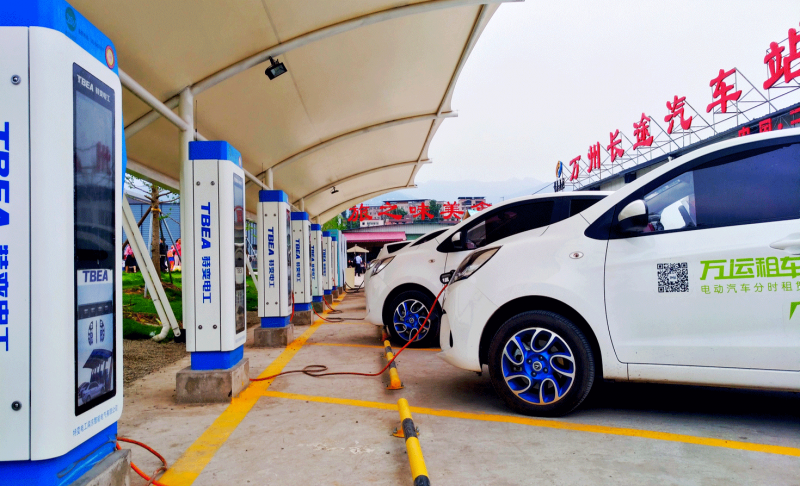China Added 963,000 Electric Vehicle Charging Piles Since January in its Push to Lead the World in EV Sales
【Summary】China continues to build out its electric vehicle charging infrastructure at a rapid pace. Since the start of the year, around 963,000 charging piles were newly built in the country, including 272,000 public EV charging piles and 691,000 private chargers. It's a 409.5% YoY increase in the number of EV chargers installed in the country.

China continues to build out its electric vehicle charging infrastructure at a rapid pace. Since the start of the year, around 963,000 charging piles were newly built in the country, including 272,000 public EV charging piles and 691,000 private ones. It's a 409.5% YoY increase in the number of EV chargers online in the country, Chinese news outlet Gasgoo reports.
The data was provided by the China Electric Vehicle Charging Infrastructure Promotion Alliance (EVCIPA). The EVCIPA was established in Oct 2015 as a non-profit social organization of major Chinese electric vehicle manufacturers, power grid companies, charging infrastructure manufacturers and operators, and third-party charging infrastructure agencies.
As of May 31, 2022, there had been 3.5 million charging piles deployed across China, up 91.5% from the same period a year ago, according to the EVCIPA.
As of May 2022, the volume of public charging piles in China had added up to 1.419 million units, including 613,000 DC piles, 806,000 AC piles, and 485 DC-AC integrated charging piles, the EVCIPA reported after analyzing the data provided by members of the alliance.
Last month alone, around 87,000 public charging piles were newly deployed in China, representing a 60.5% year-on-year increase.
China's rollout of EV charging infrastructure is much quicker than in the U.S., but that may change in the near future. As part of the Bipartisan Infrastructure Law, a total of $7.5 billion is being allocated for the construction of EV charging infrastructure in the U.S.
On June 9, the Biden-Harris Administration announced new steps to meet President Biden's goal to build out the first-ever national network of 500,000 electric vehicle chargers along America's highways and in communities, a key piece of the Bipartisan Infrastructure Law.
The administration, in partnership with the Department of Transportation and Department of Energy, is also proposing new standards for EV charging infrastructure.
The standards are intended to make charging electric vehicles (EVs) convenient, reliable, and more affordable, including when driving long distances. Without standardization, The Biden administration says that the EV chargers may not work for all cars, or lack common payment methods. Having a common set of standards also ensures that everyone can use the network, no matter what type/brand of electric vehicle they drive or which state they reside in.
President Biden is targeting a 50% share of all vehicles sold to be fully electric by 2030, but that will require significantly more EV charging infrastructure be built.
A White House fact sheet released on June 9 says the number of EV chargers in the U.S. is now 120,000, with approximately two million EVs on the road. Roughly 43,000 of these are public chargers. China however, opened 273,000 public chargers from Jan-May 2022, representing a 253.8% YoY increase.
According to the EVCIPA, there were approximately 45,000 public charging piles built per month on average across China as of May 2022. The top five provinces in China accounted for 38,373 of the new EV chargers, with Guangdong leading with 17,164 new chargers installed this year. The cities of Beijing and Shanghai added 13,291 EV chargers since January.
A March 2022 report by Cornell University's Emerging Markets Institute says that global sales of EVs are expected to grow from 4% of total car sales in 2020 to 70% by 2040, with China as the leading market.
-

Two Ford Crown Victorias Still Operating as Taxis in NYC
-

Mazda CEO's Opinion on EV Adoption in the U.S.
-

Hyundai's revolutionary powertrain design
-

Sustainability focus urged by Michelin Fleet Panel
-

BM Catalysts' UK Expansion
-

Warwick University's £12m funding for electric vehicle battery progress
-

Executive X Series: Unveiling the Powerful City/Vios Competitor
-

Hollywood couple defies expectations, showing affection after 20 years
- California DMV Accuses Tesla of Making False Claims About its Driver-Assist Systems
- 2023 Jeep Grand Cherokee Trailhawk Now PHEV Only
- Toyota’s Redesigned Prius May Get More Drivers Behind the Wheel of a Hybrid Vehicle
- Ford Unveils the F-150 Lightning Special Service Vehicle, a Fully Electric Pickup for Police Departments
- Mazda Outlines Plans to Invest $10.6 Billion in Electric and Hybrid Vehicle Development Through 2030
- Tesla Rival XPeng Inc. to Start Deliveries of its New Flagship G9 Electric SUV in September, CEO Confirms After Sharing New Details
- GM's New 'Plug And Charge' Feature Will Simplify the Charging Process For its Current & Future EVs
- The World’s First Level-4 Automated Parking Feature Developed by Mercedes-Benz and Bosch is Approved for Commercial Use
- General Motors Launches ‘EV Live’ an Interactive Virtual Experience Where Participants Can Learn More About Electric Vehicles
- General Motors is Building a Coast-to-Coast DC Fast EV Charging Network in the U.S. in a New Partnership with Travel Center Operator Pilot Company



















 About Us
About Us Contact Us
Contact Us Careers
Careers